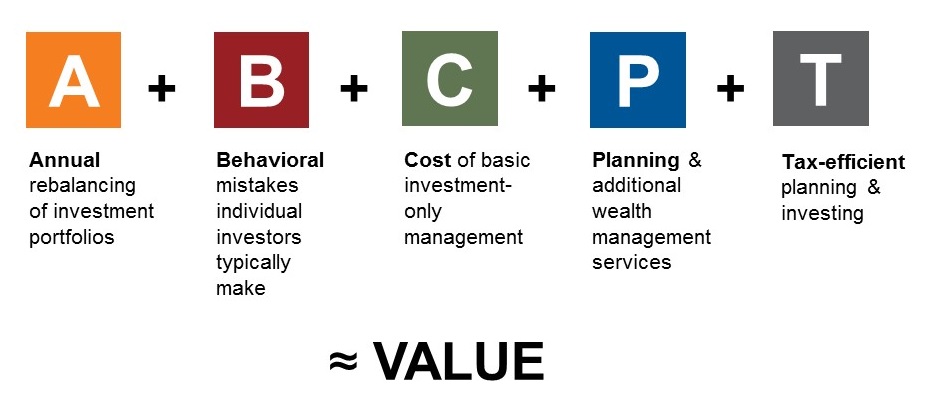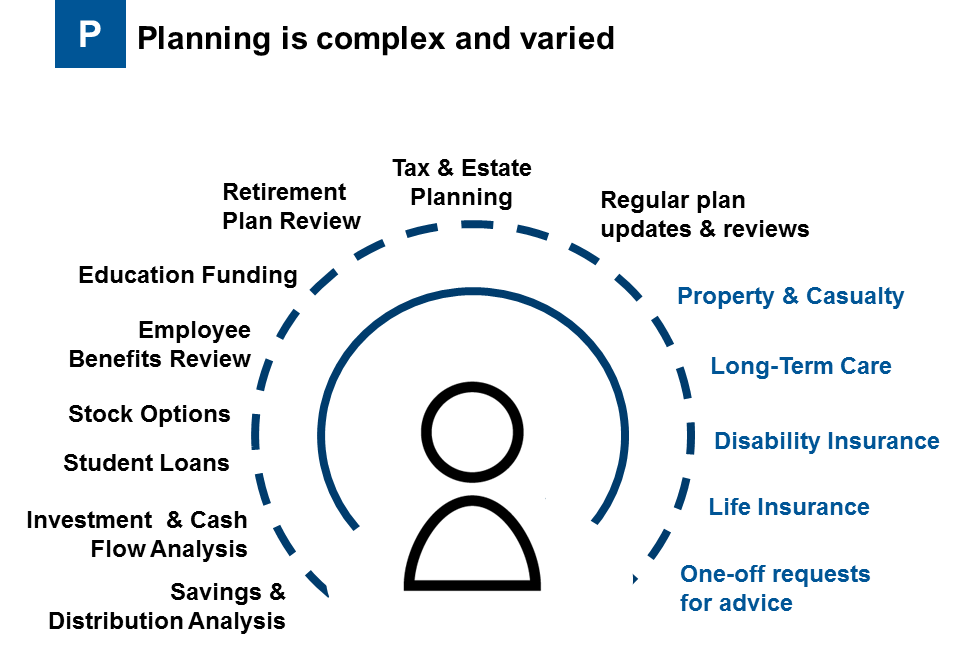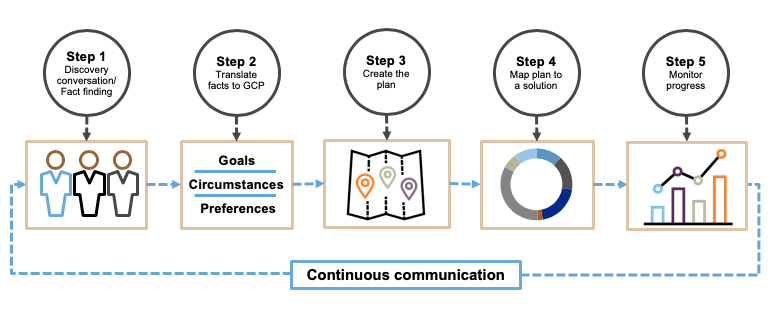P is for planning. See why it's so valuable to investors.
This is the fourth blog in a five-part series, discussing why Russell Investments believes in the value of advisors, based on this simple formula:

In this section, we’re talking about P, which stands for planning costs and ancillary services.
Planning has become table stakes in our industry, but I say that with a note of caution. When a financial plan feels like a box-checking exercise, it can be seen as a commodity. When you position your own planning process to your clients, be intentional. First of all, you, the advisor, need to recognize how important planning is and how much it is worth. Then, you need to position your planning process appropriately to your clients so that they, too, see the value. After all, planning, done correctly, is not a one-time step. It’s an ongoing process that keeps investors on track. How much is that worth?
What’s in the plan?
The items in the chart below are areas that are covered in a comprehensive plan from a quality advisor. Some advisors are only covering a handful of these areas, but we believe true wealth managers are creating more comprehensive plans, addressing at least all of the items shown in black on the chart. Per a recent financial study conducted by Michael Kitces, the average standalone planning fee for this type of comprehensive financial plan would cost about $2900 per plan. Beyond that level, the most comprehensive wealth managers may also include the blue items for their top clients. These listed items are all interconnected as well. We believe the increased complexity of that integration of these areas equals more delivered value.

Planning is important to clients. Yet advisors sometimes minimize the value that planning provides. We believe that investors have a better shot at hitting their financial goals if they have a plan, if they have a process, and if they have a partner that can help them get to the places they want to go.
The planning cycle in five steps
- Delivering wealth management begins with a deep client discovery conversation. This should be a conversation led by open-ended questions, where the advisor does more listening than talking. In some instances, for existing clients, this means going back and having a rediscovery conversation. Take the time to reflect with your clients by re-igniting a fact-finding process to ensure that all the activities and solutions are still driving toward the right outcomes.
- The next step is to translate that discovery conversation into goals, circumstances and preferences.
- Goals are the fundamental problems involving money and time that clients are trying to solve. The importance of goals must be defined by the client. Then it’s the advisor’s job to convert the stated goals into accumulation and spending milestones.
- Circumstances are the unavoidable facts that define a client’s current situation. Under the heading of circumstances, we might include a clients’ investment-account balances and their tax status, along with their stage of financial life, marital status and ability to save more or spend less.
- Preferences are a bit more flexible. These are the things that clients desire in their investment solution rather than need. Oftentimes, advisors have simplified preferences down to a risk profile, to see what risk level an investor prefers. But clients also care about their portfolio drawdown potential, cash flow consistency, and illiquidity. These days, more and more investors also approach investing from a values point of view, with preferences on portfolio holdings such as carbon, tobacco, munitions and other socially responsible issues. Advisors must always first meet goals. But the best approach is still to try to align the goals with preferences. That will lead to happier clients.
- The third step is to create the plan. In order to do so, we believe you must know where ALL of the money is located, including views into insurance, wills, trusts, mortgages, etc. We believe this holistic approach is in the best interest of investors. Without it, your plan could be operating at crossed purposes with other hidden aspects of your investor’s financial picture. We’ve seen this happen many times over the years with the advisors and investors we’ve worked this. It pays to get the complete picture so you can build the right plan the first time.
- Step four requires you to map the plan to a solution. Many of the top advisors I have coached use model portfolios for the majority of their investors, when appropriate to do so. They often use the same model portfolios as a core to build customized solutions for their suitable top clients, households and families. In addition, we observe that many of the top advisors treat taxable portfolios differently than non-taxable ones. Why? Because taxes can eat up a significant portion of your client’s return. It’s the right thing to do by the client and it can also happen to help you generate more revenue from a larger, growing base of tax-sensitive investors.
- And finally, the framework should be wrapped in a process to monitor progress, with ongoing communication between the advisor and investor, as goals, circumstances and preferences evolve over time. As I said earlier, planning is an ongoing process, not a one-time thing. Make sure your clients know this. And then make sure you do it.
The value of listening
Listening is truly a competitive advantage for advisors who do it well. Not everybody does it well. The most brilliant conversationalists are great listeners. Especially in this day and age of media talking at us, being truly heard is a rarity. Listening is the quiet key to human connection, and leads to deeper relationships with your clients. A client’s financial message, both verbal and non-verbal, is only as good as you listening to it, retaining it, and then building it into their plan. Listening done well is truly a gift to clients – and a potential opportunity for further planning. Clients can’t always articulate their financial needs, so great listening can lead to uncovering additional opportunities.
The bottom line
Don’t make the mistake, as we’ve seen with plenty of advisors, and give planning away for free during the prospecting phase. Creating full plans, then handing them to prospects who then walk out the door without implementing, is a waste of your precious time. And it doesn’t do your clients any favors either. Having a robust plan might feel reassuring, but it’s only as good as its implementation. As all good advisors know, a plan is out of date as soon as it is finalized, because life happens. The value comes from an advisor who can continuously adjust the plan to align with the client’s changing needs.
Planning is incredibly important. And its value is only going to increase. A client’s plan is the heart of their financial lives, and related life topics will continuously come your way to be incorporated. Issues like career changes, non-essential healthcare procedures and bucket-list trips will emerge for an advisor’s valued opinion. So own the value of the planning process. Don’t give it away. And make sure to recognize your value as the critical caretaker of the plan.
To learn more about the 2019 Value of an Advisor Study, click here.
